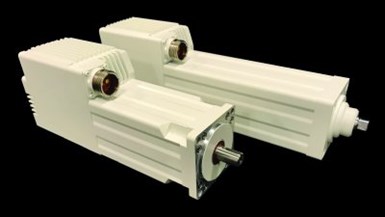Curtiss-Wright releases new motor and actuator with integral controls
The SAL080 linear actuator is reportedly capable of continuous force ratings up to 2330 lb-ft (linear) and the SA-R080 is capable of torque up to 24.7 lb-in. (rotary).
#VMAnews #controls
Edited by Chris Pasion

Curtiss-Wright’s Actuation Division has announced the release of its newest motor and actuator with integral controls, the Exlar SA-R080 rotary and SA-L080 linear actuator. Curtiss-Wright says the SA-080 is the first frame size (80 mm) in the harsh environment control.
According to Curtiss-Wright, the SA series of actuators offer force, precision, energy efficiency and control while minimizing the additional cabling, external servo controls and integration necessary with more traditional actuation solutions. The SAL080 is reportedly capable of continuous force ratings up to 2330 lb-ft (linear) and the SA-R080 is capable of torque up to 24.7 lb-in. (rotary). Utilizing 18-32VDC input voltage, the SA series actuators’ compact form can be applied across a wide range of automation applications. In addition to integral controls, the SA series offers a corrosion resistant and sealed housing, a stainless-steel output shaft, and a wide operating temperature range, ensuring long life in rugged environments.
The SA-080 series’ features include:
- Integral power and control electronics optimized for high performance
- Standard rear manual drive for emergency operation
- Magnetic absolute encoder for closed loop feedback
- Corrosion resistant epoxy housing
- High pressure seal and rod scraper for ingress protection
- Tested to MIL-STD-810G for environmental protection, corrosion resistance, vibration, and dust/sand ingress
- RS-232 and CANopen communication protocol
- SIL 3, Category 3 Safe Torque Off
- Control I/O available to work in a variety of applications
Curtis-Wright says the SA series actuators are suited for a variety of defense, industrial and commercial applications where distributed precision motion control and the need to operate in harsh environments is required, such as in mobile equipment and other outdoor installations. In addition, electromechanical actuation reportedly offers better energy efficiency and less environmental impacts and maintenance compared to traditional fluid power alternatives.
RELATED CONTENT
-
The Role of Valves in HAZOP Studies
Process hazard analysis (PHA) is required by U.S.
-
The Diverse Role Valves Play in the Chemical Industry
The chemical industry is extremely diverse with more than 60,000 known products. Like all process industries, the chemical industry needs valves designed for safe, efficient and reliable process operation.
-
Valves in Space
All of these valves need to be built to precise fits and finishes and to stringent performance requirements because “On a spacecraft, everything has got to work. If it breaks, you’re done.”











 Unloading large gate valve.jpg;maxWidth=214)